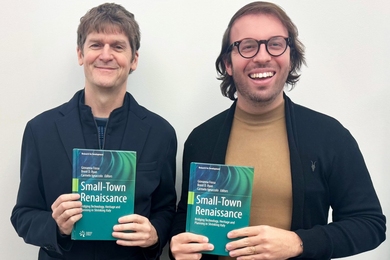Living cells are bombarded with messages from the outside world -- hormones and other chemicals tell them to grow, migrate, die or do nothing. Inside the cell, complex signaling networks interpret these cues and make life-and-death decisions.
Unraveling these networks is critical to understanding human diseases, especially cancer, and to predicting how cells will react to potential treatments. Using a "fuzzy logic" approach, a team of MIT biological engineers has created a new model that reveals different and novel information about these inner cell workings than traditional computational models.
The team, led by Doug Lauffenburger, head of MIT's Department of Biological Engineering, reports its findings in the April 3 issue of the journal Public Library of Science (PLoS) Computational Biology.
This is the first time that scientists have applied fuzzy logic modeling to experimental cell biochemistry data, and the approach should be applicable to any kind of cell signaling pathway, said Lauffenburger.
Developed in the 1960s, fuzzy logic can take inexact inputs and produce accurate predictions, based on sets of rules rather than mathematical equations. It has been applied in auto-focusing cameras, automobile cruise control and home appliances.
Fuzzy logic mimics the way humans make everyday decisions -- for example, deciding when to eat lunch. The decision depends on what time it is, what is in the refrigerator, how hungry you are, etc. All of this information is integrated to come up with a decision, with no math required.
The new MIT model works the same way. Each component of the cell-signaling network (which could be a receptor, enzyme or transcription factor) has its own set of rules that determine how it responds to a particular stimulus. Adding up all of these stimuli and responses leads to an outcome, such as death, cell division or migration.
In contrast, traditional computational models use physics-based equations to calculate precise values for each interaction. To create such models requires more specific biochemical knowledge and they do not offer the same insights as the fuzzy logic models.
While both types of model accurately predict outcomes of a pathway, fuzzy logic models also generate a graphical representation of each step along the way, allowing scientists to visualize what is happening inside the cell. With fuzzy logic models, "you can actually see the drawing and say, 'Aha, I see what this enzyme is doing,'" said Lauffenburger.
The researchers' model allowed them to discover some previously unknown interactions in a pathway regulating programmed cell death. The pathway, called MK2, is generally believed to promote cell death and produces cell-to-cell communication factors involved in inflammation-based tissue destruction. However, the model showed that inhibiting MK2 can actually favor cell death, because it indicated that the pathway may also control another signal that is pro-survival.
This finding demonstrates that molecular components in the cellular network governing survival-versus-death decisions can promote diverse outcomes, so simple intuition cannot readily predict the effects of possible drug treatments.
Without the fuzzy logic model, "you wouldn't have found that connection and would not be able to properly understand what an anti-MK2 drug might do," said Lauffenburger.
This general modeling approach should be useful in identifying potential new targets for drugs against cancer, inflammatory diseases and infectious diseases, he said.
Lead author of the paper is Bree Aldridge, a recent MIT PhD recipient in biological engineering (BE). Other authors are Julio Saez-Rodriguez, research affiliate in BE and postdoctoral fellow at Harvard Medical School; Jeremy Muhlich, research scientist at Harvard Medical School; and Peter Sorger, Harvard Medical School professor of systems biology and MIT professor of BE .
Funding support was provided by the National Institute of General Medical Sciences Systems Biology Centers of Excellence program and the Department of Defense Institute for Collaborative Biotechnologies.
A version of this article appeared in MIT Tech Talk on April 8, 2009 (download PDF).





